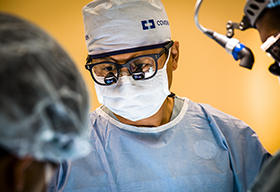Sunnybrook Regional Secondary Stroke Prevention Clinic
|
Clinic Scope |
Sunnybrook’s Regional Secondary Stroke Prevention Clinic is a leading provincial designated outpatient stroke prevention clinic that specializes in consultations for diagnostic assessment of patients with stroke, transient ischemic attack (TIA), and other cerebrovascular disorders, and treatment recommendations aimed at reducing the risk of recurrent strokes. The clinic is staffed by a dedicated team of academic stroke physicians, clinical nurse specialists, and trainees in supervised practice. It is an approved training site for medical residents and fellows. Our staff physicians are affiliated with the University of Toronto and actively engaged in patient care, medical education, and research to improve patient outcomes. |
|
Eligibility Criteria |
Catchment: The clinic primarily serves the North and East Greater Toronto Area stroke network (regional geographic catchment area). Referrals from across Ontario are considered on a case by case basis. Age: 18 years and older Medical Diagnosis: The clinic’s primary focus is on diagnosis and secondary stroke prevention treatment for individuals with an ischemic stroke, TIA, intracerebral hemorrhage, or other types of cerebrovascular disease. The clinic also provides consultations for stroke prevention for patients with specific stroke risk factors such as carotid artery disease and atrial fibrillation. The clinic is for non-acute, non-urgent stroke/TIA cases; it is not an emergency clinic. Requests for consultation must come from a physician referral containing the reason for referral and relevant medical information. Referrals are reviewed in a triage process for urgency and appropriateness and may be redirected if not suitable for the clinic. |
|
Exclusion Criteria |
1. Referrals for general neurology problems or a non-stroke/TIA related diagnosis or issue 2. Referrals primarily for stroke rehabilitation or pain management Referrals for urgent management of acute stroke or TIA (Note: patients experiencing acute stroke or TIA symptoms should call 9-1-1 and seek emergency department assessment) |
|
Link |
|
|
Fax |
Please fax referrals to 416-480-5753. |






